PEP小学英语六年级上册各单元知识点复习资料
- 格式:doc
- 大小:62.50 KB
- 文档页数:6
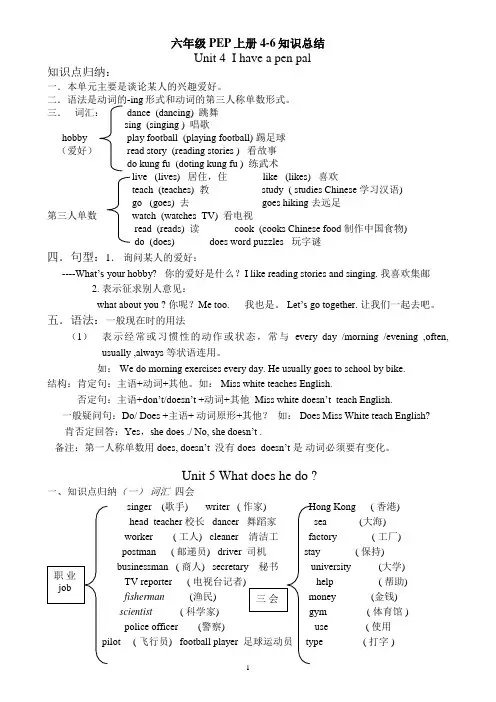
六年级PEP 上册4-6知识总结Unit 4 I have a pen pal知识点归纳:一.本单元主要是谈论某人的兴趣爱好。
二.语法是动词的-ing 形式和动词的第三人称单数形式。
三. 词汇: dance (dancing) 跳舞 sing (singing ) 唱歌hobby play football (playing football) 踢足球(爱好) read story (reading stories ) 看故事do kung fu (doting kung fu ) 练武术live (lives) 居住,住 like (likes) 喜欢 teach (teaches) 教 study ( studies Chinese 学习汉语)go (goes) 去 goes hiking 去远足第三人单数 watch (watches TV) 看电视read (reads) 读 cook (cooks Chinese food 制作中国食物)do (does) does word puzzles 玩字谜四.句型:1. 询问某人的爱好:----What’s your hobby? 你的爱好是什么?I like reading stories and singing. 我喜欢集邮2. 表示征求别人意见:what about you ? 你呢?Me too. 我也是。
Let’s go together. 让我们一起去吧。
五.语法:一般现在时的用法(1) 表示经常或习惯性的动作或状态,常与every day /morning /evening ,often,usually ,always 等状语连用。
如: We do morning exercises every day. He usually goes to school by bike.结构:肯定句:主语+动词+其他。
如: Miss white teaches English.否定句:主语+don ’t/doesn ’t +动词+其他 Miss white doesn ’t teach English.一般疑问句:Do/ Does +主语+ 动词原形+其他? 如: Does Miss White teach English?肯否定回答:Yes ,she does ./ No, she doesn’t .备注:第一人称单数用does, doesn ’t 没有does doesn ’t 是 动词必须要有变化。
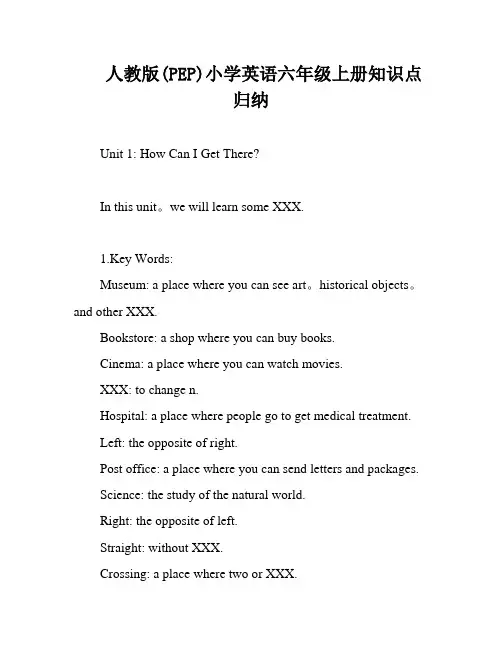
人教版(PEP)小学英语六年级上册知识点归纳Unit 1: How Can I Get There?In this unit。
we will learn some XXX.1.Key Words:Museum: a place where you can see art。
historical objects。
and other XXX.Bookstore: a shop where you can buy books.Cinema: a place where you can watch movies.XXX: to change n.Hospital: a place where people go to get medical treatment.Left: the opposite of right.Post office: a place where you can send letters and packages.Science: the study of the natural world.Right: the opposite of left.Straight: without XXX.Crossing: a place where two or XXX.eful Phrases:Post office: "Where is the post office?"Science museum: "Where is the science museum?"Pet hospital: "Where is the pet hospital?"XXX: "Where is XXX?"XXX: "Where is Beihai Park?"Palace Museum: "Where is the Palace Museum?"Go straight: "Go straight and you will see the bookstore on your left."Turn right/left: "Turn right at the crossing and you will see the hospital on your right."Next to: "The cinema is next to the bookstore."In front of: "The school is in front of the park."Near the park: "XXX is near the park."XXX: "XXX."mon ns:Excuse me: "Excuse me。
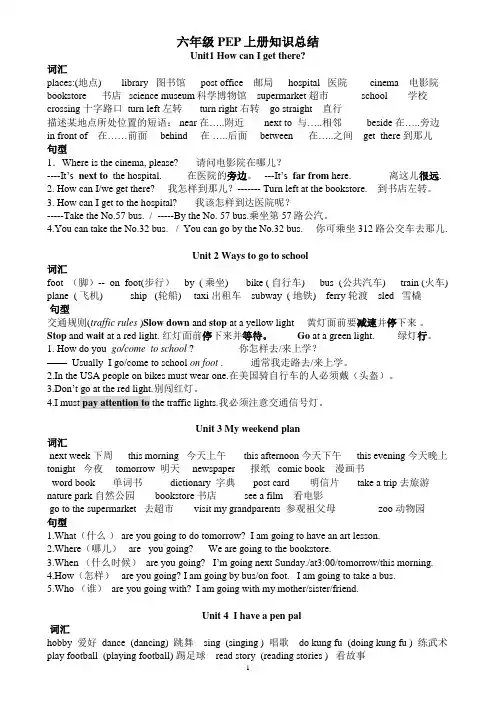
六年级PEP上册知识总结Unit1 How can I get there?词汇places:(地点) library 图书馆 post office 邮局 hospital 医院 cinema 电影院bookstore 书店 science museum科学博物馆 supermarket 超市 school 学校crossing 十字路口 turn left 左转 turn right 右转 go straight 直行描述某地点所处位置的短语: near 在…..附近 next to 与…..相邻 beside 在…..旁边in front of 在……前面 behind 在…..后面 between 在…..之间 get there 到那儿句型1.Where is the cinema, please? 请问电影院在哪儿?----It’s next to the hospital. 在医院的旁边。
---It’s far from here. 离这儿很远.2. How can I/we get there? 我怎样到那儿?------- Turn left at the bookstore. 到书店左转。
3. How can I get to the hospital? 我该怎样到达医院呢?-----Take the No.57 bus. / -----By the No. 57 bus.乘坐第57路公汽。
4.You can take the No.32 bus. / You can go by the No.32 bus. 你可乘坐312路公交车去那儿.Unit 2 Ways to go to school词汇foot (脚)-- on foot(步行) by ( 乘坐) bike ( 自行车) bus (公共汽车) train (火车) plane ( 飞机) ship (轮船) taxi 出租车 subway ( 地铁) ferry 轮渡 sled 雪橇句型交通规则(traffic rules )Slow down and stop at a yellow light 黄灯面前要减速并停下来。
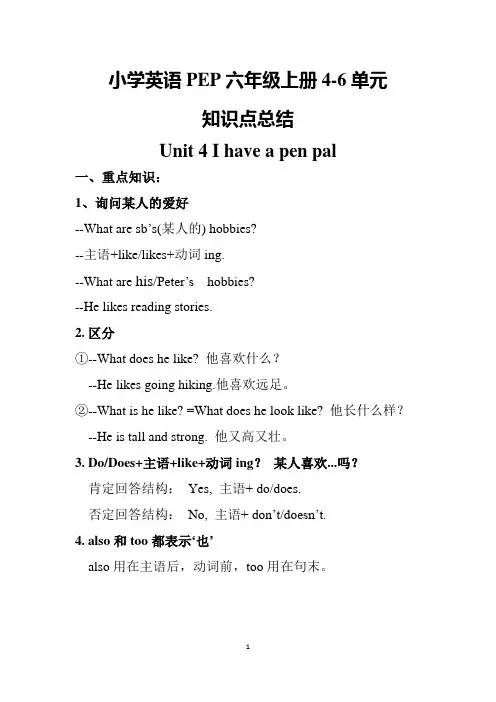
小学英语PEP六年级上册4-6单元知识点总结Unit 4 I have a pen pal一、重点知识:1、询问某人的爱好--What are sb’s(某人的) hobbies?--主语+like/likes+动词ing.--What are his/Peter’s hobbies?--He likes reading stories.2.区分①--What does he like? 他喜欢什么?--He likes going hiking.他喜欢远足。
②--What is he like? =What does he look like? 他长什么样?--He is tall and strong. 他又高又壮。
3.Do/Does+主语+like+动词ing?某人喜欢...吗?肯定回答结构:Yes, 主语+ do/does.否定回答结构:No, 主语+ don’t/doesn’t.4.also和too都表示‘也’also用在主语后,动词前,too用在句末。
5.宾语6.区别What is his hobby?(单数)What are his hobbies?(复数)7.be interested in对...感兴趣二、动词变三单:1、一般情况是在动词后加-s如:read - reads,write - writes,say – says2、以s,x,ch,sh,结尾的词加-es如:teach - teaches,wash - washes,3、①以辅音字母+y结尾的词变y为i再加-es如:try - tries②元音直接+s如:play -plays4、不规则变化如:have- has go-goes do-does三、动词ing变化规则:1、一般情况下,直接在动词后加-ing如:study ----- studying2、以不发音的e结尾,要去e加ing如:take - taking make -- making dance ---- dancing3、双写词尾字母,再加-ing如:run ----- runningswim----swimmingshop-shopping四、如何把肯定句变成一般疑问句1.如果有be动词和情态动词,直接把他们放在句首,I,we变成you2.句中没有be动词和情态动词,则根据主语借助do/does,后面的动词用原形(I,we变成you,主语是三单才用does 其他用do)补充:be动词包括am,is,are;情态动词:can,must,will,should五.如何变否定句1.句中有be动词或情态动词直接在其后加not2.句中无be动词或情态动词,根据主语用don’t或doesn’t 放在主语后,且后面的动词用原形。
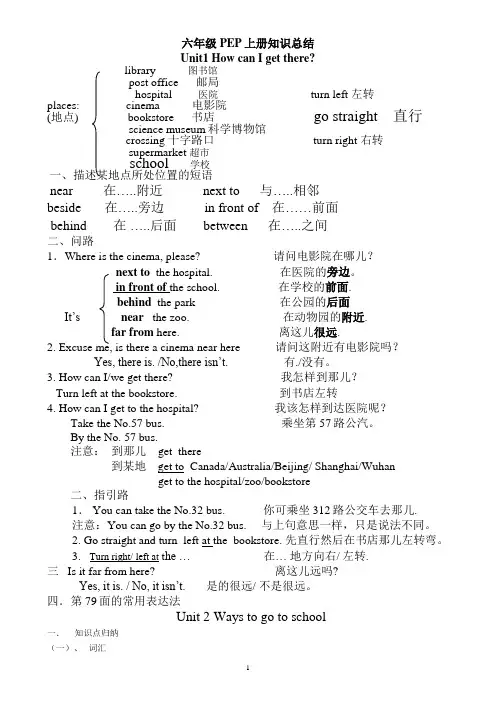
六年级PEP上册知识总结Unit1 How can I get there?library 图书馆post office 邮局hospital 医院turn left 左转places: cinema 电影院(地点) bookstore 书店go straight 直行science museum科学博物馆crossing 十字路口 turn right 右转supermarket 超市school 学校一、描述某地点所处位置的短语near 在…..附近 next to 与…..相邻beside 在…..旁边 in front of 在……前面behind 在…..后面 between 在…..之间二、问路1.Where is the cinema, please? 请问电影院在哪儿?next to the hospital. 在医院的旁边。
in front of the school. 在学校的前面.behind the park 在公园的后面It’s near the zoo. 在动物园的附近.far from here. 离这儿很远.2. Excuse me, is there a cinema near here 请问这附近有电影院吗?Yes, there is. /No,there isn’t. 有./没有。
3. How can I/we get there? 我怎样到那儿?Turn left at the bookstore. 到书店左转4. How can I get to the hospital? 我该怎样到达医院呢?Take the No.57 bus. 乘坐第57路公汽。
By the No. 57 bus.注意:到那儿 get there到某地 get to Canada/Australia/Beijing/ Shanghai/Wuhanget to the hospital/zoo/bookstore二、指引路1. You can take the No.32 bus. 你可乘坐312路公交车去那儿.注意:You can go by the No.32 bus. 与上句意思一样,只是说法不同。
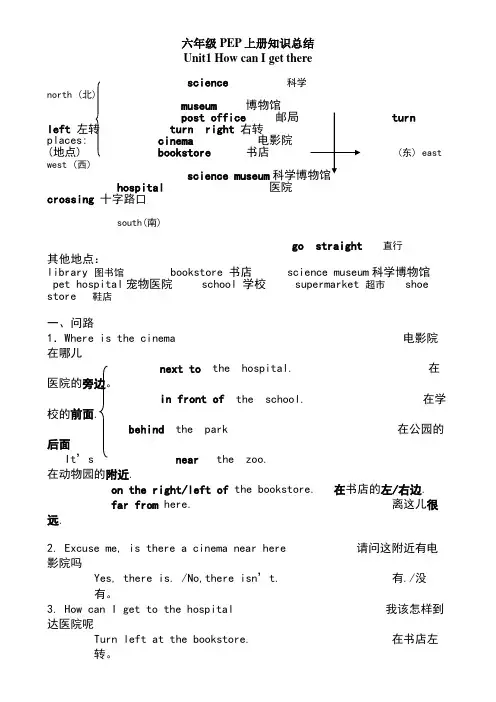
六年级PEP上册知识总结Unit1 How can I get therescience科学north (北)museum 博物馆post office邮局 turnleft左转turn right 右转places: cinema 电影院(地点) bookstore 书店 (东) east west (西)science museum科学博物馆hospital医院crossing 十字路口south(南)go straight直行其他地点:library 图书馆 bookstore 书店 science museum科学博物馆pet hospital宠物医院 school 学校 supermarket 超市shoe store 鞋店一、问路1.Where is the cinema 电影院在哪儿next to the hospital. 在医院的旁边。
in front of the school. 在学校的前面.behind the park 在公园的后面It’s near the zoo. 在动物园的附近.on the right/left of the bookstore. 在书店的左/右边.far from here. 离这儿很远.2. Excuse me, is there a cinema near here 请问这附近有电影院吗Yes, there is. /No,there isn’t. 有./没有。
3. How can I get to the hospital 我该怎样到达医院呢Turn left at the bookstore. 在书店左转。
can we get there 我们怎样到那二、指引路1. You can take the bus. 你可乘坐5路公交车去那儿.2. Go straight for three minutes. 向前直走在分钟.3. Turn right/ left a t the … 在… 地方向右/ 左转.三、 Is it far from here 离这儿远吗Yes, it is. / No, it isn’t.是的很远/ 不是很远。
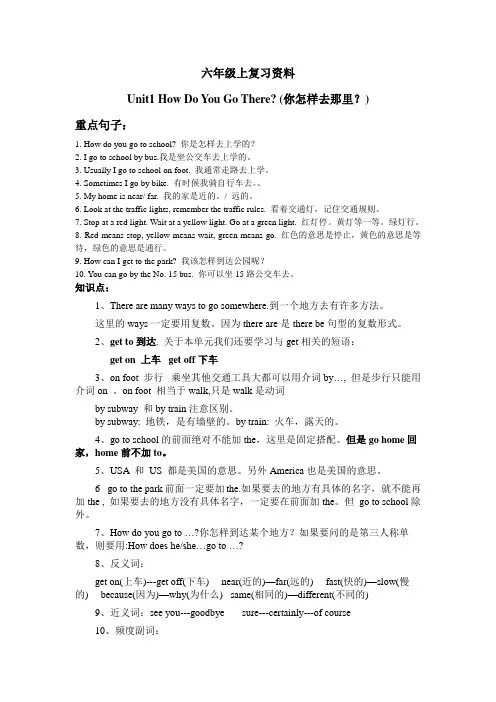
六年级上复习资料Unit1 How Do You Go There? (你怎样去那里?)重点句子:1. How do you go to school? 你是怎样去上学的?2. I go to school by bus.我是坐公交车去上学的。
3. Usually I go to school on foot. 我通常走路去上学。
4. Sometimes I go by bike. 有时候我骑自行车去。
、5. My home is near/ far. 我的家是近的。
/ 远的。
6. Look at the traffic lights, remember the traffic rules. 看着交通灯,记住交通规则。
7. Stop at a red light. Wait at a yellow light. Go at a green light. 红灯停。
黄灯等一等。
绿灯行。
8. Red means stop, yellow means wait, green means go. 红色的意思是停止,黄色的意思是等待,绿色的意思是通行。
9. How can I get to the park? 我该怎样到达公园呢?10. You can go by the No. 15 bus. 你可以坐15路公交车去。
知识点:1、There are many ways to go somewhere.到一个地方去有许多方法。
这里的ways一定要用复数。
因为there are是there be句型的复数形式。
2、get to到达. 关于本单元我们还要学习与get相关的短语:get on 上车get off下车3、on foot 步行乘坐其他交通工具大都可以用介词by…, 但是步行只能用介词on 。
on foot 相当于walk,只是walk是动词by subway 和by train注意区别。
by subway: 地铁,是有墙壁的。
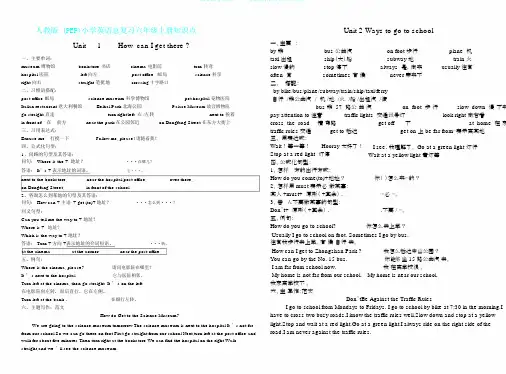
人教版 (PEP)小学英语总复习六年级上册知识点Unit1How can I get there ?一、主要单词:museum 博物馆bookstore 书店cinema 电影院turn 转弯hospital 医院left 向左post office邮局science 科学right 向右straight 笔挺地crossing 十字路口二、习惯语搭配:post office 邮局science museum 科学博物馆pet hospital 宠物医院Italian restaurant 意大利餐馆Beihai Park 北海公园Palace Museum 故宫博物院go straight 直走turn right/left 右 /左转next to 挨着in front of... 在 ...前方near the park 在公园邻近on Dongfang Street 在东方大街上三、习用表达式:Unit 2 Ways to go to school一、主要:by 乘bus 公共汽on foot 步行plane 机taxi 出租ship(大)船subway 地train 火slow 慢的stop 停下always 是,向来usually 往常often 常sometimes 有候never 素来不二、搭配:by bike/bus/plane/subway/train/ship/taxi/ferry自行 /乘公共汽 / 机 /地 /火 /船 /出租汽 /渡bus 乘 57 路公共汽on foot 步行slow down 慢下来pay attention to 注意traffic lights 交通讯号灯look right 向右看cross the road横穿路get off下at home 在家traffic rules 交通get to 抵达get on 上be far from⋯表示离某地Excuse me打搅一下Follow me, please! 请随着我!四、公式化句型:1、问路的句型及其答语:问句: Where is the + 地址?···在哪儿?答语: It’s + 表示地址的词语。
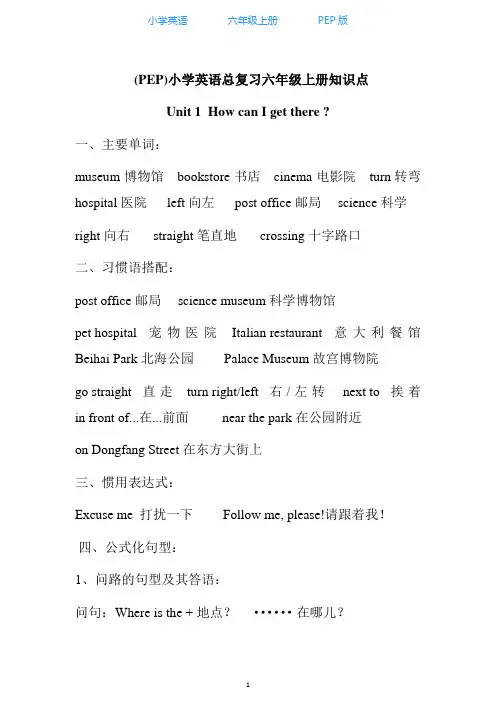
(PEP)小学英语总复习六年级上册知识点Unit 1 How can I get there ?一、主要单词:museum博物馆 bookstore书店 cinema电影院 turn 转弯hospital医院 left向左 post office 邮局 science科学right向右 straight笔直地 crossing十字路口二、习惯语搭配:post office邮局 science museum科学博物馆pet hospital宠物医院 Italian restaurant意大利餐馆Beihai Park北海公园Palace Museum故宫博物院go straight直走 turn right/left右/左转next to挨着in front of...在...前面near the park在公园附近on Dongfang Street在东方大街上三、惯用表达式:Excuse me 打扰一下 Follow me, please!请跟着我!四、公式化句型:1、问路的句型及其答语:问句:Where is the + 地点?······在哪儿?答语:It's + 表示地点的词语(next to the bookstore, near the hospital/post office, over there,on Dongfang Street, in front of the school... )2、询问怎么到某地的句型及其答语:问句:How can +主语 + get (to)+地点?·····怎么到·····?同义句型: Can you tell me the way to +地点?Where is + 地点? Which is the way to +地点?五、例句:Where is the cinema, please? 请问电影院在哪里?It's next to the hospital. 它与医院相邻。
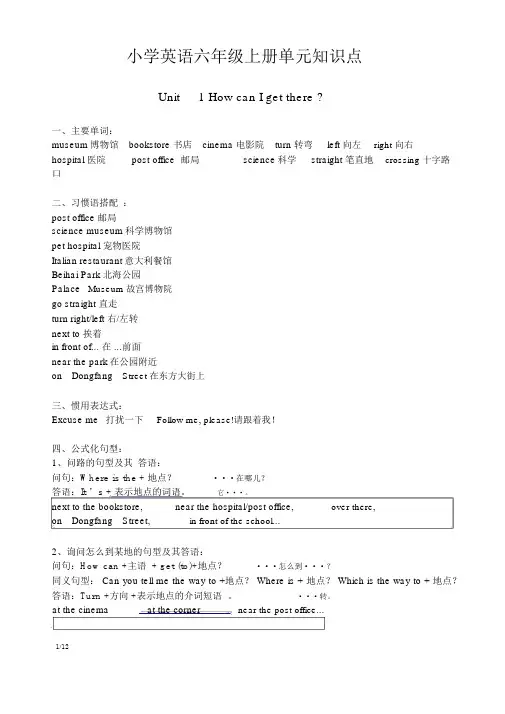
小学英语六年级上册单元知识点Unit 1 How can I get there ?一、主要单词:museum博物馆bookstore 书店cinema 电影院turn 转弯left 向左right 向右hospital 医院post office 邮局science科学straight 笔直地crossing 十字路口二、习惯语搭配:post office 邮局science museum科学博物馆pet hospital 宠物医院Italian restaurant意大利餐馆Beihai Park 北海公园Palace Museum 故宫博物院go straight 直走turn right/left 右/左转next to 挨着in front of... 在 ...前面near the park在公园附近on Dongfang Street 在东方大街上三、惯用表达式:Excuse me打扰一下Follow me, please!请跟着我!四、公式化句型:1、问路的句型及其答语:问句:Where is the + 地点?···在哪儿?答语:It ’s + 表示地点的词语。
它···。
next to the bookstore,near the hospital/post office,over there,on Dongfang Street,in front of the school...2、询问怎么到某地的句型及其答语:问句:How can +主语 + get (to)+地点?···怎么到···?同义句型: Can you tell me the way to +地点? Where is + 地点? Which is the way to + 地点?答语:Turn +方向 +表示地点的介词短语。
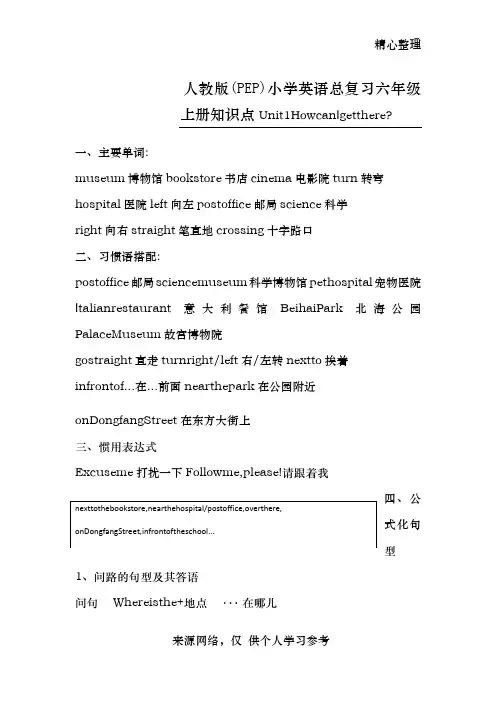
精心整理人教版(PEP)小学英语总复习六年级上册知识点Unit1Howcan I getthere? 一、主要单词:museum 博物馆bookstore 书店cinema 电影院turn 转弯:sciencemuseum talianrestaurantExcuseme 打扰一下 1Whereisthe+nexttothebookstore,nearthehospital/postoffice,overthere,I t’s+表示地点的词语。
它···。
2Howcan+主语+get(to)+the+Canyoutellmethewayto+Whereis+Whichisthewayto+Turn+方向+表示地点的介词短语。
atthecinemaatthecornernearthepostoffice...Whereisthecinema,please?I t’snexttothehospital.它与医院相邻。
Turnleftatthecinema,thengostraight.I t’sontheleft.在电影院向1、Whereisthemuseumshop?博物馆商店在哪里?I t’snearthedoor.他在门附近。
2、Whereisthepostoffice?邮局在哪里?I t’snexttothemuseum.它与博物馆相邻。
3、Whereistherestaurant?餐馆在哪里?I t’snexttothetheparkonDongfangStreet.它与东方街上的公园相邻。
Unit2Waystogotoschoolby乘bus公共汽车onfoot步行plane飞机taxi出租车ship subway地铁train火车slow慢的stop停下always usually通常often经常sometimes有时候never从来不,永不Wait Hooray I see.绿灯行Stopataredlight红灯停Waitatayellowlight1Howdoyoucome(to)+2、如何用must某人+must++.···必须···。
PEP小学六年级上册英语知识点归纳PEP六年级上册知识点归纳Unit1 How can I get there?XXX)post office邮局XXXturn left左转turn right右转places:。
cinema电影院地点)。
bookstore书店go XXXcrossing十字路口supermarket超市school学校一、描述某地点所处位置的短语near在…。
附近next to与…。
相邻XXX在…。
旁边in front of在……前面XXX在…。
后面XXX在…。
之间2、问路1.Where is the cinema。
please?请问电影院在哪儿?XXX在医院的旁边。
XXX在学校的前面.XXX在公园的背面It’XXX在植物园的邻近.XXX.离这儿很远.2.Excuse me。
is there a cinema near here请问这附近有电影院吗?Yes。
there is。
/No,there isn’t.有./没有。
3.How can I/we get there?我怎样到那儿?XXX left XXX到书店左转4.How can I get to the hospital?我该如何抵达病院呢?Take the No.57 bus.乘坐第57路公汽。
By the No。
57 bus.注意:到那儿get。
there到某地get to。
Canada/XXX二、指引路1.You can take the No.32 bus.你可乘坐32路公交车去那儿.注意:You can go by the No.32 bus.与上句意思一样,只是说法不同。
2.Go straight and turn。
left at the。
bookstore.先直行然后在书店那儿左转弯。
3.Turn right/ left at the …在…地方向右/左转.三Is it far from here?离这儿远吗?Yes。
一、1至3单元内容概述PEP(小学英语教材)六年级上册的1至3单元主要内容包括词汇、语法和语音等知识点。
这些知识点涵盖了日常生活中常用的基础英语表达,帮助学生建立起扎实的英语基础。
二、词汇知识点1. 单词拼写:六年级上册的1至3单元中包含了大量的基础单词,如数字、颜色、家庭成员等。
学生需要牢记这些单词的拼写,并能够正确运用到日常交流中。
2. 词组搭配:除了单词的拼写,学生还需要掌握一些常用的词组搭配,如时间短语、动词短语等。
这些词组搭配能够帮助学生更准确、流利地表达自己的意思。
3. 日常用语:六年级上册的1至3单元中也包含了一些常用的日常用语,如问候语、表达喜好等。
这些日常用语对于学生来说十分实用,能够帮助他们在日常生活中更好地与外国人交流。
三、语法知识点1. 时态:在1至3单元中,学生将学习到一些基本的时态,如一般现在时、一般过去时等。
掌握好这些时态的使用对学生来说非常重要,能够帮助他们正确地描述过去和现在的事情。
2. 语法结构:学生还需要掌握一些基本的语法结构,如肯定句、否定句、疑问句等。
这些基本的语法结构是构建语言表达能力的基石,对学生的语言能力提升有着重要的作用。
四、语音知识点1. 发音准确性:在1至3单元中,学生将学习一些基础的英语发音规则,包括元音、辅音的发音技巧等。
通过反复练习,帮助学生提高发音的准确性,使他们能够更加清晰地表达自己的意思。
2. 语音连读:学生还需要学习一些基本的语音连读规则,如连读音、重读音等。
这些规则能够帮助学生更好地理解和模仿地道的英语发音,提高他们的口语表达能力。
五、总结PEP六年级上册的1至3单元涵盖了大量的英语基础知识,包括词汇、语法和语音等方面。
通过系统的学习和练习,学生能够建立起扎实的英语基础,为今后的英语学习打下坚实的基础。
这些知识点也是学生未来学习更复杂英语知识的基础,对于学生的英语学习之路具有重要的意义。
在前面的内容中,我们已经对PEP六年级上册1至3单元的知识点进行了概述,包括词汇、语法和语音等方面。
六年级上复习资料Unit1 How Do You Go There? (你怎样去那里?)重点单词:on foot= walk走路by bike骑自行车by bus坐公车by train坐火车by plane坐飞机by ship坐轮船by subway坐地铁near近的far远的usually通常sometimes有时候easy简单的the fifth floor第五层楼traffic lights交通灯traffic rules交通规则stop停止wait等待get to到达same相同的mean意思是driver司机right 右边left左边must必须know知道重点句子:1. How do you go to school? 你是怎样去上学的?2. I go to school by bus.我是坐公交车去上学的。
3. Usually I go to school on foot. 我通常走路去上学。
4. Sometimes I go by bike. 有时候我骑自行车去。
、5. My home is near/ far. 我的家是近的。
/ 远的。
6. Look at the traffic lights, remember the traffic rules. 看着交通灯,记住交通规则。
7. Stop at a red light. Wait at a yellow light. Go at a green light. 红灯停。
黄灯等一等。
绿灯行。
8. Red means stop, yellow means wait, green means go. 红色的意思是停止,黄色的意思是等待,绿色的意思是通行。
9. How can I get to the park? 我该怎样到达公园呢?10. You can go by the No. 15 bus. 你可以坐15路公交车去。
重点知识:1.坐某种交通工具用by,例如:by bike, by train。
而走路用“on”例如on foot.2.国家名字,地方名字第一个字母要大些:例如:Canada加拿大, China中国, America美国,England英国,Australia澳大利亚3.国家名缩写前面加the,缩写字母都要大写。
例如:the USA=the US美国,the UK英国,the CAN加拿大,the PRC中国。
4.频度副词是表示做的次数多少的词语。
从多到少依次排列为:always总是,usually通常,often经常,sometimes有时候,never从不。
频度副词可以放在句首,也可以放在人称后面。
例如:Usually I go to school by bus. = I usually go to school by bus.5.near近的,far远的。
这两个词是一对反义词。
注意:not near= far, not far = near.6.时间前面用at. 例如:在三点钟:at 3 o’ clock. 一段时间前面用for7.表达第几层楼的时候我们要用序数词,前面还要有the。
例如:第一、二、三、四、五层楼分别是:the first floor. the second floor. the third floor. the fourth floor. the fifth floor. 8.交通灯traffic lights,交通规则:traffic rules。
这两个词后面都一定要加s, 绝对不能少。
因为交通灯有红黄绿三盏,一定是复数,交通规则不可能只有一条,所以都一定要加s,考试的时候千万别忘了加s哦!9.大部分的国家都是靠右行驶的:drivers drive on the right side of the road. 记住Englandand Australia, drivers drive on the left side of the road.英国和澳大利亚,司机是靠左行驶的。
10.常用交通标志:参见课本第12页中内容。
11.on foot= walk, 都是走路的意思,但是用法不同,on foot用在句子末尾,而walk用法与go相同,可以代替go的位置。
例如:走路回家:walk home 走路去上学:walk to school 走路去上班walk to work 走路去医院walk to the hospitalUnit2 Where is the Science Museum? 科学博物馆在哪?重点单词:where哪里library图书馆bookstore书店post office邮局hospital医院cinema 电影院near旁边next to旁边(比near更近)in front of在…的前面behind在...的后面Excuse me打扰一下please请far from离…远的buy买want to想要a pair of一双get on上车get off下车on the left在左边on the right在右边east 东south南west西north北turn left左转turn right右转go straight直走am上午pm下午now现在tell告诉look for寻找重点句子:1.Where is the cinema, please? 请问电影院在哪?2.It’s next to the hospital. 它在医院的旁边。
3.Is it far from here? 它离这远吗?4.It’s east of the cinema. 它在电影院的东面。
5.Turn left at the cinema, then go straight. It’s on the left. 在电影院左转,然后直走,它在左边。
重点知识:1.问路之前,出于礼貌,我们要说“Excuse me”与后面的句子要用标点符号隔开。
2.Is there 开头的问句怎么回答呢?例如:Is there a cinema near here? 只要把前两个词语的顺序换一下就可以了,肯定回答是:Yes, there is. 否定:No, there isn’t.3.buy 和by的区别,这两个词语发音相同,但是意思完全不同,by:乘,坐buy:买4.地点名词前面一定要有the,例如:Where is the cinema? How can I get to the hospital?5.时间前面用at. 例如:在三点钟:at 3 o’ clock.;一段时间前面用for,例如:三分钟for 3minutes. 星期前面用on,例如:on Monday, on Tuesday, on Wednesday, on Thursday, on Friday, on Saturday, on Sunday.6.在表达第几路公交车时,注意No. 的书写,N要大写,后面别少了一点!!!7.在哪里上下车,在哪里左右转,都用介词at,例如:Get on/ off at the cinema. 在电影院的地方上下车。
Turn left/ right at the bookstore. 在书店的地方左右转。
8.by the No. 12 bus= take the No. 12 bus. 坐12路公交车Unit3 What are you going to do? 你将要做什么?重点单词:take a trip旅行read a magazine读一本杂志go to the cinema去看电影this morning今天上午this afternoon今天下午this evening今天晚上next week下个星期tomorrow明天tonight今晚busy忙碌的go home回家post card明信片comic book漫画书newspaper报纸dictionary字典plant trees种树重点句子:1.What are you going to do on the weekend? 周末你将要做什么?2.I’m going to visit my grandparents this weekend. 我将要去拜访我的祖父母。
3.I’m going to have a busy weekend! 我将要度过一个忙碌的周末。
4.I’m going to the supermarket with my mother. 我将要和我妈妈去超市。
5.Where are you going this afternoon? 今天下午你将要去哪?6.I’m going to the bookstore. 我将去书店。
7.What are you going to buy? 你将要买什么?8.I’m going to buy a comic book. 我将要去买一本漫画书。
9.When are you going? 你将什么时候去?10.I’m going at 3 o’clock. 我将三点钟去。
11.What are you going to be? I’m going to be a policeman. 你将要成为什么样的人?我将要成为一名警察。
重点知识:1.时间往往放在句子的末尾。
例如:What are you going to do this evening?2.go to school去上学,go to work去上班,go to the cinema去看电影,go后面都要有to,但是要注意“回家”这个词组是:go home,中间绝对没有to。
3.with: 和,后面往往跟人。
例如:I’m going to play football with my friends. 我将要和我的朋友一起去踢足球。
4.疑问词:where:哪里(地点)what:什么(东西,事情或职业)when:什么时候(时间)how:怎么样(交通工具)who:谁(人)why:为什么(答句中有because)5.注意buy与by的区别。
buy:买by: 乘,坐6.plant有两个意思:种;植物。
例如:plant trees种树plant shop植物商店7.注意区别What are you going to be?和What are you going to do?前者是问将要成为什么样的人;后者是问将要做什么事情。
Unit4 I have a pen pal 我有一个笔友重点单词:pen pal笔友riding a bike(ride)骑自行车diving(dive)跳水playing the violin(play)拉小提琴collecting stamps(collect)集邮making kites(make)做风筝drawing pictures (draw)画画painting (paint)画画skating(skate)溜冰hobby爱好show展览live (lives) in Beijing居住在北京go (goes) to work去上班go (goes) to bed睡觉go (goes) home回家teach(teaches)English教英语read (reads) newspapers读报纸watch (watches)TV看电视重点句子:1.What’s your hobby? 你的爱好是什么?2.I like collecting stamps.我喜欢集邮。